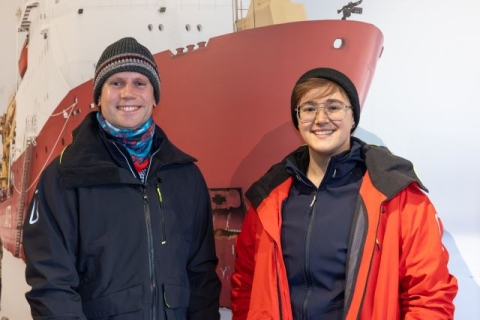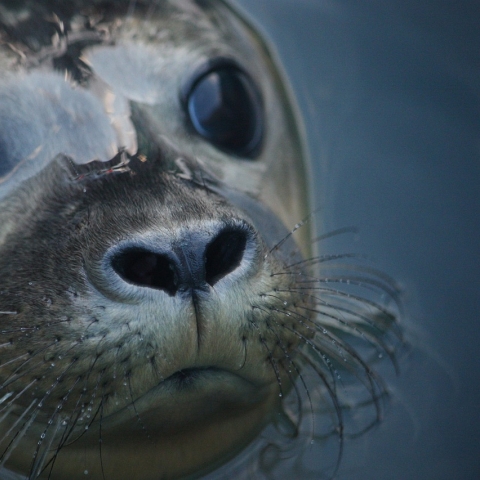

Scientists from the University of Portsmouth embark on an expedition to investigate the effects of tourism and climate change in Antarctica.
7 November 2024
3 minutes
This Christmas, scientists from the University of Portsmouth will embark on an expedition to investigate the effects of tourism and climate change in Antarctica.
Living aboard HMS Protector, the Royal Navy’s icebreaker, they will spend five weeks immersed in the freezing waters of the Southern Ocean.
The mission, which runs throughout November and December, aims to gather crucial data on pollution from increased tourism and the far-reaching impacts of climate change on this fragile environment.
Two experts from the University of Portsmouth will be participating in this critical research, they will be leaving for their trip on the 15th November.
I’m thrilled to undertake fieldwork where I won’t have to worry about scorpions under my bed or fight wasps to take a shower.
Dr Adele Julier, Senior lecturer at the University of Portsmouth
Deciphering weather patterns of the past
Dr Adele Julier, a senior lecturer and palaeoecologist, will focus on understanding wind and weather patterns through modern pollen collection techniques. Dr Julier’s work involves using pollen, charcoal, and other particles from sediments to decipher the environmental conditions of the past. By analysing pollen carried to Antarctica by the wind, she aims to calibrate historical climate data and track shifts in weather patterns.
Dr Julier, who has spent over a decade studying pollen in tropical climates, is excited about this colder adventure: “I’m thrilled to undertake fieldwork where I won’t have to worry about scorpions under my bed or fight wasps to take a shower!” She is especially looking forward to seeing the Adélie penguins, native to Antarctica.
Her three-pronged approach to collecting pollen includes using microscope slides to catch daily pollen, artificial pollen traps to collect weekly samples, and natural moss banks that serve as long-term pollen traps. Her research will help us better understand the ongoing climate changes in the region.
It’s a once-in-a-lifetime opportunity and will contribute to critical research that could shape the future of tourism in Antarctica.
Dr Keiron Roberts, Senior lecturer in sustainability and the built environment, and member of the Revolution Plastics Institute
Environmental impact of tourism
Dr Keiron Roberts, a senior lecturer in sustainability and the built environment, and a member of the Revolution Plastics Institute, will be investigating the environmental impact of tourism. With over 100,00 tourists visiting Antarctica during the 2023-24 season, the region is experiencing unprecedented human activity, which could have far-reaching consequences on the ecosystem.
Dr Roberts, who trained as an oceanographer, will be collecting surface water samples to measure nutrient levels, metals, and antimicrobial resistance - indicators of human pollution. He also plans to use a plankton trawl net to capture microplastics and a sediment grab to assess long-term environmental changes.
Additionally, Dr Roberts will fly drones to survey the coastline for litter in hard-to-reach areas, helping build a comprehensive picture of the impact tourism has on this delicate ecosystem.
“This trip allows me to return to my roots in oceanography while incorporating my passion for sustainability”, Dr Roberts said. “It’s a once-in-a-lifetime opportunity and will contribute to critical research that could shape the future of tourism in Antarctica.”
This research trip by University of Portsmouth scientists could provide valuable insights into both climate change and the sustainability of tourism in one of the world’s most pristine and delicate environments.
HMS Protector is equipped with everything needed to assist the scientists with their research projects. The ship has a full sonar suite as well as a small survey boat equipped with a multi-beam echo sounding system that can survey the sea floor at shallow depths, close to calving glacier margins. High tech-equipment is used to collect data quickly and accurately in extreme conditions.
HMS Protector’s Commanding Officer, Captain Tom Weaver, said: “HMS Protector’s mission in Antarctica provides valuable opportunities for scientists to access the world’s most important natural laboratory.
“Last year we embarked two scientists from the University of Portsmouth to research water pollution and glacier change in Antarctica and I’m delighted that during this Austral summer season the Royal Navy can continue to support the University of Portsmouth and their environmental research.”
Antarctica tales with Professor Fay Couceiro
0:01
I love playing with all the equipment in the lab, but I really like getting outside and Environmental Pollution allowed me to do both.
0:07
It allowed me to get out into the environment, to keep those areas that I enjoy using, rivers and the sea, clean,
0:13
and I've always wanted to do polar work, but all my work so far has been temperate or tropical.
0:19
And so when I had the opportunity to go to Antarctica and look at pollution levels, I jumped at it.
0:29
The first iceberg we saw was actually on quite a grey day.
0:32
It was really far away, and all the people who were new to Antarctica were so excited.
0:37
We all took 100 photos of the same iceberg getting slowly, slowly closer.
0:42
And all the people who had been before just kept saying, "just wait".
0:45
And as we then moved along and the days progressed, we just saw the more and more spectacular icebergs
0:51
and of course the weather cleared up and they were beautiful colours as well.
0:55
We were going through Lemaire Channel, which is sometimes known as Kodak Valley because everyone takes so many pictures.
1:01
And then we had humpback whales feeding right next to the ship as we went through the channel.
1:07
And just...
1:09
It was so peaceful.
1:10
Everybody on the ship who wasn't working was outside watching it, and we were all silent because we were all awestruck.
1:17
It was really quite a special moment.
1:23
The cruise ship industry has really taken off going towards Antarctica.
1:28
So what I wanted to do was check what that meant for the water quality in the areas where there are regular visitors.
1:34
And I looked for heavy metals, microplastics and antimicrobial resistance genes.
1:40
These are all different ways that humans can impact the local environment.
1:46
The next step is to actually analyse those samples.
1:49
It's going to be at least six months or possibly longer before all of the analysis is finished.
1:54
That data will then be shared both with the general public, the Navy, and also IAATO the International Association of Antarctic Tour Operators.
2:04
Each of those people have a say in who can go to Antarctica and what policies they must follow whilst they're there.
2:11
They can make the decisions about whether the number of cruise liners going is fine, whether they should decrease it,
2:17
but also if there are any improvements that can be made to those ships.
2:22
Small differences about how the water is released from those ships could make a big difference to the quality of the water in Antarctica.
2:31
I guess what I want people to think about with microplastics is that they are reaching these areas where that we have considered pristine,
2:39
they have been found at the top of Everest and they have found in Antarctica.
2:42
So things that we are doing here in our homes are reaching all the way to the other side of the planet.
2:48
Where possible I think it's important for people to think about the impacts and to see what we can do to reduce the amount of plastic that we use as a whole,
2:56
which will ultimately reduce the amount of microplastics produced.
More like this...
University of Portsmouth to investigate presence and impact of microplastics in Arctic and Antarctica
23 May 2024
3 minutes

Data collected by record-breaking rowers builds a unique picture of coastal biodiversity
The biodiversity data collected by a team of rowers as they raced around Great Britain last year has been published in a new report.
14 May 2024
6 min read

How will climate change affect the microplastics in our environment?
5 June 2024
3 minutes

